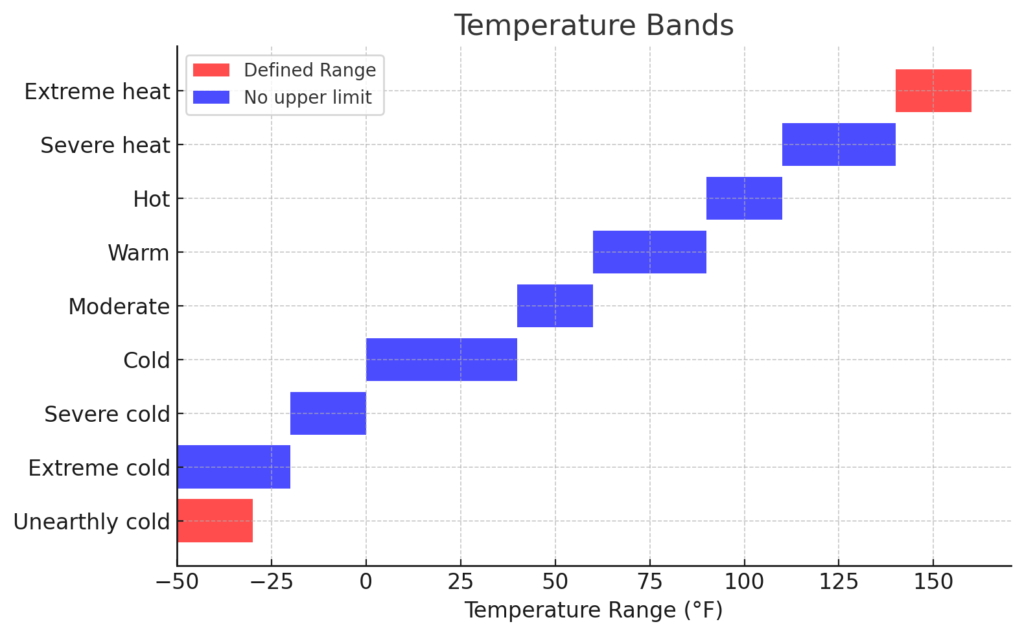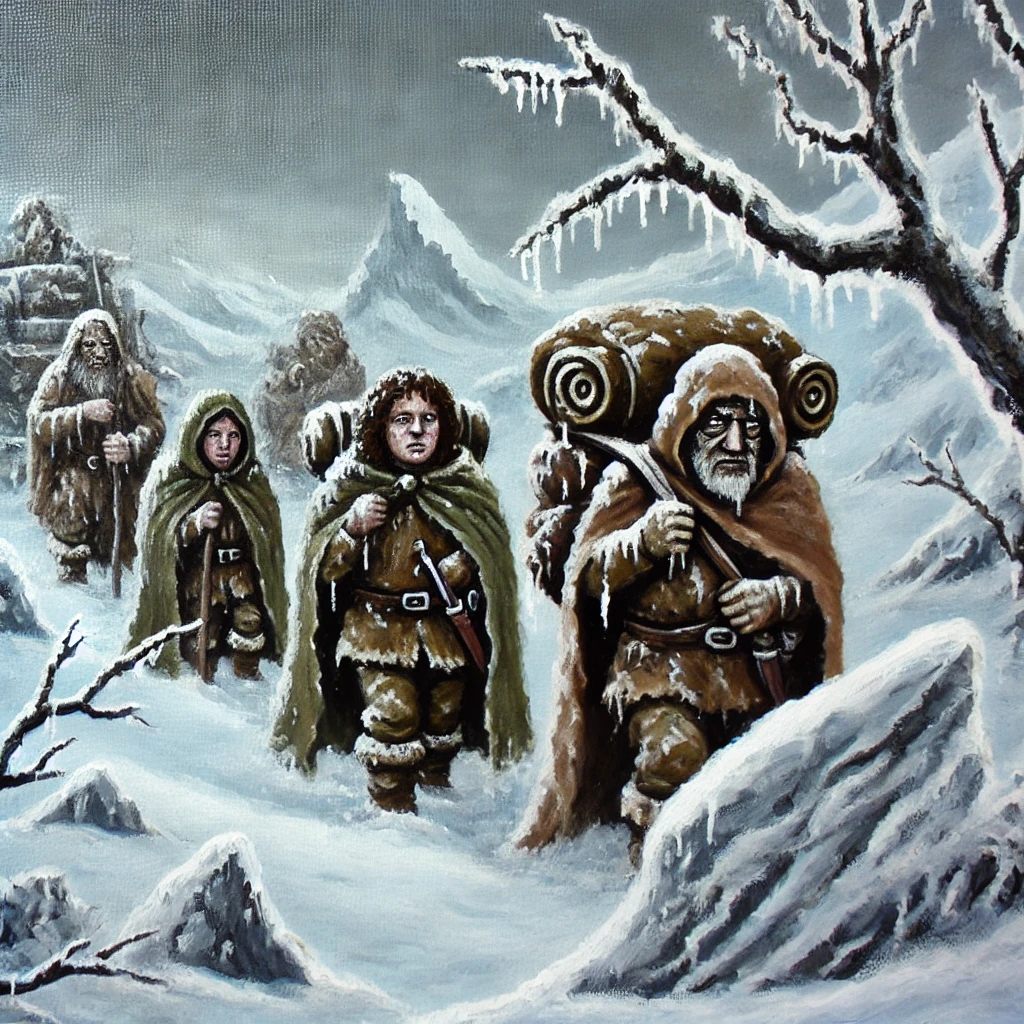
The Unforgiving Chill of Cold Weather
In the cold band or lower, the environment becomes a silent killer, ready to claim the unprepared. The frigid air itself becomes an adversary, stripping warmth with every breath and draining strength from even the hardiest adventurers. Those skilled in survival have a fighting chance, their knowledge providing bonuses to resist the creeping cold and even extending that aid to companions. Yet, skill alone is often not enough; protection is the true key to survival in these hostile conditions.
Cold: A Harbinger of Suffering
Even at its mildest, the cold begins its assault. Unprotected characters must endure hourly tests of endurance to stave off nonlethal damage. A failure signals the creeping advance of frostbite and exhaustion. Cold weather outfits or the Cold Endurance feat offer a basic level of protection, shielding wearers from this initial threat, but these are only the first line of defense in an escalating battle.
Severe Cold: The Relentless Onslaught
When the temperature plummets further, the danger grows with terrifying speed. In severe cold, unprotected individuals face the relentless toll of the environment every ten minutes, their bodies failing against the unyielding freeze. The partially protected -those wrapped in furs or layered clothing - may stretch this reprieve to an hour. Only with advanced gear or magical assistance, granting a level 2 protection or higher, can one withstand this onslaught and continue their journey.
Extreme Cold: Death in the Air
Extreme cold offers no mercy. Here, the air becomes a weapon, dealing direct cold damage to the unprotected every ten minutes. Beyond this, even the lightest contact with exposed metal becomes a hazard, mimicking the effects of a chill metal spell. Only those with level 3 protection or higher can claim full immunity to the environment's brutality. Lesser protections offer only fleeting respite, and even then, survival is a tenuous prospect.
Unearthly Cold: The Edge of Oblivion
At its most malevolent, the cold becomes a force of nature, destroying all it touches. Unearthly cold strikes unprotected characters with both physical and nonlethal damage every minute. This merciless pace spares no one who ventures into such realms unprepared. Only with the highest levels of protection - level 4 or greater - can anyone hope to endure the wrath of this frozen abyss. Even partially protected individuals are battered by its cruelty, their survival hanging by a thread as they face damage every ten minutes.
Variations in the Killing Cold
The perils of cold weather intensify with altitude, the coming of night, and the cruel bite of wind. High peaks transform what was once moderate warmth into deadly chill, dropping temperatures by one or even two bands at elevations above 5,000 feet. Nightfall brings its own terrors, plunging temperatures by one or two steps, particularly in arid regions where the contrast between day and night is stark. Strong winds, though not lowering the temperature directly, accelerate heat loss, creating the illusion of a colder, more brutal environment.

Protection: A Fragile Shield Against Nature's Wrath
Few dare to face the icy wilderness without some form of protection. Cold weather clothing, heavy furs, and magic provide a lifeline against the cold's unyielding assault. Levels of protection, ranging from 0 to 5 or beyond, determine a character's ability to survive. Proper preparation can mean the difference between enduring and succumbing to the frost's grasp. Even so, no protection confers resistance to magical cold attacks; a white dragon's breath or a cone of cold spell remains as deadly as ever, unaffected by mundane or magical defenses.
The cold is more than a simple environmental hazard; it is a living force, hunting the weak and the careless. Those who underestimate it risk everything, for the frost does not forgive and offers no second chances. Only through vigilance, preparation, and determination can one hope to endure its frozen dominion.
Common Hazards of Frost
Frost is more than just a layer of icy beauty - it's a harbinger of danger, capable of turning the simplest of tasks into life-threatening challenges. For those traveling through frozen realms, frost presents a range of hazards that can cripple the unprepared and test even the most seasoned adventurers.
Frostbite: The most immediate danger, frostbite occurs when exposed skin freezes. Fingers, toes, noses, and ears are particularly vulnerable. If untreated, frostbite can lead to permanent tissue damage or loss of the affected extremities.
Hypothermia: Prolonged exposure to cold lowers the body's core temperature, causing confusion, sluggishness, and eventual loss of consciousness. Hypothermia is one of the leading causes of death in icy environments.
Slippery Terrain: Frost and ice make every step treacherous. Slips and falls are common, especially on unseen patches of black ice. Such accidents can lead to broken bones or worse, depending on the environment.
Obscured Vision: Frost clinging to goggles, visors, or natural formations like trees and rocks can obscure vision, making navigation perilous. This increases the likelihood of getting lost or falling into unseen dangers like crevasses.
Ice Falls: In frosty landscapes, icicles and overhanging ice formations can break and fall, posing a lethal threat to anyone below. Even small chunks of falling ice can cause severe injury when falling from height.
Frozen Equipment: Frost renders gear brittle or nonfunctional. Rope stiffens, metal tools become too cold to handle without protection, and mechanisms can freeze solid, making them useless in critical moments.
Cold Burns: Prolonged contact with cold metal surfaces can cause burns similar to heat burns, painfully damaging skin and flesh. This is especially common when touching frosted weapons, tools, or armor.
Impeded Movement: Frosty environments often lead to deep snowdrifts, icy slopes, or frozen rivers that slow progress to a crawl. For those unprepared, this can mean exhaustion, isolation, and heightened exposure to other dangers.
Snow Blindness: Light reflecting off frost and snow can cause temporary blindness if eyes are not properly shielded, making travel during daylight hazardous.
Avalanches and Ice Shifts: Frosted terrain can give way unpredictably, triggering avalanches or causing cracks in ice sheets. These phenomena can bury, trap, or crush those caught in their path.
Concealed Traps: Frost can obscure natural and artificial hazards. Thin ice may cover deep water, snow may hide crevasses, and frost-covered ruins can mask dangerous traps or unstable structures.
Frost doesn't simply surround adventurers; it actively works against them, turning every aspect of survival into a struggle. Proper preparation - adequate clothing, gear, and a keen understanding of the environment - can mitigate its dangers, but even the best-prepared must remain vigilant. In the realm of frost, carelessness is a death sentence.
Frostbite and How to Prevent It
Frostbite is a severe condition caused by prolonged exposure to cold temperatures, where the skin and underlying tissues freeze. It typically affects extremities like fingers, toes, ears, and the nose - areas farthest from the body's core where blood circulation is reduced during cold exposure. If left untreated, frostbite can lead to permanent tissue damage, infection, or even amputation.
Stages of Frostbite
- Frostnip: This is the earliest stage, where the skin turns red or pale and feels cold. Numbness or tingling may occur, but no permanent damage happens at this stage.
- Superficial Frostbite: The skin begins to freeze, turning white or grayish-yellow. Ice crystals may form within the skin, causing it to feel hard and frozen. The underlying tissue remains pliable, but this stage can result in blistering.
- Deep Frostbite: In severe cases, both skin and underlying tissues, including muscles and nerves, freeze. The area becomes numb, cold, and hard. As frostbite progresses, the skin may turn black, indicating necrosis (tissue death).
Symptoms of Frostbite
- Cold and numb skin
- Tingling or stinging sensations
- Pale, white, or grayish skin
- Hard or waxy texture
- Blisters during the healing process
- Severe cases may lead to blackened, dead tissue
Prevention of Frostbite
Dress Appropriately: Layer clothing to trap heat and protect against the cold. Start with a moisture-wicking base layer, add insulating layers like wool or fleece, and finish with a waterproof and windproof outer layer.
Protect Extremities: Wear insulated gloves or mittens, thick socks, and a hat or balaclava to protect the head and ears. Use insulated, waterproof boots to shield feet from cold and wet conditions.
Stay Dry: Wet clothing dramatically increases heat loss. Keep yourself dry by wearing water-resistant outer layers and promptly changing out of wet garments.
Cover All Skin: Exposed skin is vulnerable to frostbite. Use scarves, masks, or balaclavas to cover the face, and avoid leaving gaps between clothing layers.
Keep Moving: Physical activity boosts circulation, helping to keep extremities warm. Regularly wiggle fingers and toes if standing still for extended periods.
Avoid Tight Clothing: Restrictive clothing or footwear can impede blood circulation, increasing the risk of frostbite.
Stay Hydrated and Nourished: Dehydration and lack of energy reduce the body's ability to generate heat. Drink warm, non-alcoholic beverages and consume calorie-dense foods.
Limit Exposure: Avoid prolonged exposure to cold weather when possible. Seek shelter and warm up regularly if you must stay outside for extended periods.
Monitor for Warning Signs: If you notice tingling, numbness, or pale skin, take immediate action to warm the affected area.
First Aid for Frostbite
- Get to a Warm Place: Remove the person from the cold environment and shield them from the wind.
- Warm the Affected Area Gradually: Use warm (not hot) water, ideally between 100-104°F, to slowly rewarm the frostbitten area. Do not use direct heat sources like stoves or fireplaces.
- Avoid Rubbing or Massaging: This can worsen tissue damage.
- Keep the Affected Area Elevated: Elevation reduces swelling and promotes blood flow.
- Do Not Rewarm if Refreezing Is Possible: Rewarming followed by refreezing causes even more severe damage.
- Seek Medical Attention: Deep frostbite and severe cases require immediate professional care.
Frostbite is a preventable condition, but it demands vigilance and preparation in cold environments. Proper clothing, hydration, and awareness of the signs are crucial to ensuring frostbite doesn't turn a frosty adventure into a dire ordeal.






